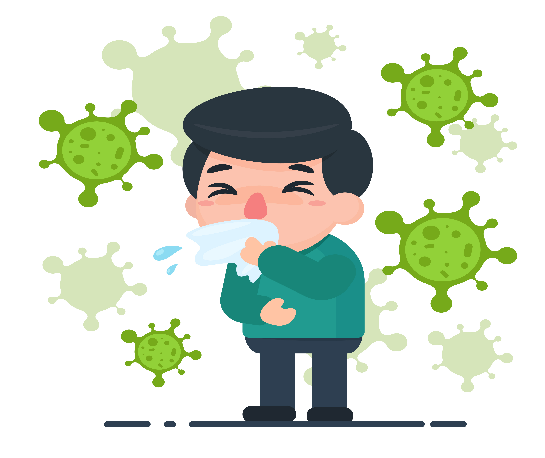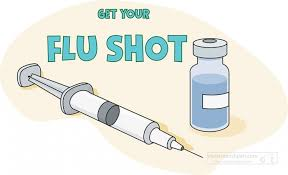Disclaimer [ENGLISH]
Influenza is commonly known as the flu, and both terms will appear throughout this publication.
What is the flu?

- A contagious illness caused by the influenza virus.
- The virus is spread through respiratory droplets. It spreads easily in childcare settings.
- The virus is constantly changing and is different every year.
- While most people experience respiratory symptoms, influenza can affect the whole body.
- In the United States, influenza infections usually happen in the fall and winter – this is called “flu season”. Sometimes flu season can last into the spring too.
- It is NOT the same thing as the “stomach flu” which typically causes vomiting and diarrhea.
What are the symptoms of the flu?
- Symptoms usually develop within 1-4 days after contact with someone who has the flu.
- Your child will usually feel the worst during the first 2-3 days of being sick.
- Your child might suddenly develop a high fever. Fever might last for 2-5 days. There might be chills and shaking (shivering) with the fever.
- Sore throat
- Cough. Cough can last for 2-3 weeks. Your child might cough up phlegm of many different colors.
- Stuffy and/or runny nose. Runny nose can last for 1-2 weeks.
- Fatigue
- Body aches, muscle aches
- Headache
- Throwing up (vomiting) and loose, runny stools (diarrhea)
How is the flu diagnosed?
- Your child’s healthcare provider might test for influenza with a nasal swab. You will usually have the results of this test before you leave the office.
- Testing with nasal swabs is the only reliable way to differentiate between the flu and COVID.

- Based on your child’s symptoms, their healthcare provider might diagnose them with influenza without doing the test.
How can I prevent the flu?
The Flu Shot
Getting the flu vaccine (“the flu shot) is the best way to prevent influenza.
- All babies and children 6 months and older need an influenza vaccine every fall.
- Because the influenza virus is changing all the time, the vaccine is different every year.
- Most often, the flu shot prevents getting any flu infection. If you have been vaccinated but still get the flu, the shot still helps to reduce your symptoms.
- Since there are many different influenza viruses, your child should still get a flu shot even if they have had the flu – it can protect them from getting sick with a different version of the virus.
- If you have questions about the flu vaccine, please discuss them with your child’s healthcare provider.
Good Hygiene

- Cover the nose and mouth with a tissue when coughing or sneezing. Throw the tissue away and wash your hands.
- Wash hands often.
- Don’t share cups, utensils, towels, or toothbrushes.
- Clean frequently touched surfaces often. This includes doorknobs, countertops, toilet handles, and toys.
If your child has been exposed to someone with influenza
- Anti-viral medications MIGHT help prevent infections in some high-risk children.
- Please contact your child’s healthcare provider if you think they might need medication.
How is this treated?
Supportive Care
- Most children will benefit from “supportive care”.
- This means treating the symptoms your child has so they feel more comfortable.
- Click here to learn how to treat your child’s symptoms.
Anti-Viral Medications
- Anti-viral medications (such as tamiflu) might be recommended by your child’s healthcare provider.
- Most healthy children do not need this treatment.
- Treatment is recommended for children with underlying medical conditions, those under 2 years old, and those with severe symptoms.
- These medications can help decrease the length of symptoms by 1-2 days if started in the first 48hours of being sick.
This is a virus infection. Antibiotics DO NOT treat virus infections. Some children develop bacterial infections (like ear infections or pneumonia) after they have the flu – these infections are treated with antibiotics.
When can my child return to school and other activities?
ALL of the following conditions must be met before returning:
- They have been fever-free for 24 hours without the use of any medications like acetaminophen or ibuprofen.
- Their other symptoms are improving.
- They feel well enough to participate in normal activities.
When to call your doctor:
- Fever lasts for more than 5 days.
- Fever resolves for 1 or 2 days and then returns.
- Your child is having difficulty breathing.
- Your child complains of ear pain.
- Your child is having difficulty drinking and is showing signs of dehydration (such as: no urination for 8 hours, dry mouth, no tears when crying).
- Your child is getting worse or developing new concerning symptoms.
- Your child seems to be improving and then suddenly gets worse.
- You have other questions, concerns, or think your child needs to be seen.
This publication was adapted from information from American Academy of Pediatrics patient education materials.
Reviewed by: AR D.O., TT D.O. | 1/2024


